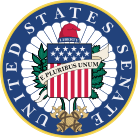United States Senate Committee on Rules and Administration facts for kids
| Standing committee | |
|---|---|
Active United States Senate 116th Congress |
|
| History | |
| Formed | December 9, 1874 |
| Leadership | |
| Chair | Roy Blunt (R) |
| Ranking member | Amy Klobuchar (D) |
| Structure | |
| Political parties | Majority (10)
|
| Jurisdiction | |
| Policy areas | Books, manuscripts and monuments to the memory of individuals, Congressional office buildings, Congressional Record, Corrupt practices, Credentials and qualifications of members of the Senate, Federal elections generally, Government Publishing Office, Meetings of the Congress and attendance of members, Presidential succession, Senate library, statuary and works of art in the Capitol, Smithsonian Institution, Standing Rules of the United States Senate, United States Botanic Garden |
| Oversight authority | Architect of the Capitol, Congressional Research Service, FEC, EAC, GPO, Historian of the United States Senate, Library of Congress, Parliamentarian of the United States Senate, Secretary of the Senate, Sergeant at Arms of the United States Senate, Smithsonian Institution, United States Botanic Gardens, United States Senate Curator, United States Senate Library |
| Website | |
| https://www.rules.senate.gov/ | |
| Rules | |
|
|
The Senate Committee on Rules and Administration is often called the Senate Rules Committee. This important group helps run the United States Senate. It sets the rules for how the Senate works. It also manages the buildings where Congress meets. The committee watches over elections and helps decide if senators are qualified to serve.
What the Committee Does
The Senate Rules Committee has many jobs. Rule XXV of the Senate's rules lists what this committee is in charge of. Here are some of its main tasks:
- Managing Senate Buildings: It takes care of the Senate Office Buildings and the Senate part of the Capitol. This includes deciding where senators have their offices.
- Setting Senate Rules: The committee creates and updates the rules for how the Senate operates. This includes rules for debates and for visitors in the Senate gallery.
- Ensuring Fair Practices: It looks into issues related to fair conduct and practices.
- Checking Senator Qualifications: The committee checks the qualifications of people who want to be senators. It also handles questions about election results.
- Overseeing Federal Elections: It helps manage federal elections across the country. This includes elections for the President, Vice President, and members of Congress.
- Working with the Government Publishing Office: It works with the Government Publishing Office. This office prints official government documents, like the Congressional Record.
- Managing Congressional Meetings: The committee helps organize meetings of Congress. It also deals with how members attend these meetings.
- Handling Senate Money: It approves how money is spent from the Senate's special fund.
- Presidential Succession: It deals with rules about who takes over as President if something happens to the current President.
- Buying Books and Art: The committee is in charge of buying books and old writings (manuscripts). It also helps create monuments to remember important people.
- Senate Library and Art: It oversees the Senate Library. It also manages the statues, art, and pictures in the Capitol and Senate Office Buildings.
- Providing Senate Services: This includes services for senators, like the Senate restaurant.
- Overseeing Key Institutions: It helps manage the Library of Congress, the Smithsonian Institution, and the United States Botanic Garden.
Committee Members (116th Congress)
The Senate Rules Committee has members from both the Republican and Democratic parties. The 116th Congress had these members:
| Majority | Minority |
|---|---|
|
|
Related Pages

All content from Kiddle encyclopedia articles (including the article images and facts) can be freely used under Attribution-ShareAlike license, unless stated otherwise. Cite this article:
United States Senate Committee on Rules and Administration Facts for Kids. Kiddle Encyclopedia.
